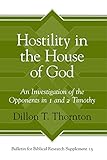Hostility in the house of God : an investigation of the opponents in 1 and 2 Timothy / Dillon T. Thornton. [print]
Material type: TextSeries: Bulletin for biblical research supplements ; 15Publication details: Winona Lake, Indiana : Eisenbrauns, (c)2016.Description: xiv, 322 pages ; 24 cmContent type:
TextSeries: Bulletin for biblical research supplements ; 15Publication details: Winona Lake, Indiana : Eisenbrauns, (c)2016.Description: xiv, 322 pages ; 24 cmContent type: - text
- unmediated
- volume
- 9781575064468
- BS2745.T513.H678 2016
- BS2745
- COPYRIGHT NOT covered - Click this link to request copyright permission:
| Item type | Current library | Collection | Call number | Status | Date due | Barcode | |
|---|---|---|---|---|---|---|---|
 Circulating Book (checkout times vary with patron status)
Circulating Book (checkout times vary with patron status)
|
G. Allen Fleece Library CIRCULATING COLLECTION | Non-fiction | BS2745.52.T46 2016 (Browse shelf(Opens below)) | Available | 31923001746714 |
Browsing G. Allen Fleece Library shelves, Shelving location: CIRCULATING COLLECTION, Collection: Non-fiction Close shelf browser (Hides shelf browser)
| No cover image available |

|
No cover image available |

|

|

|

|
||
| BS2745.5.M6 The second epistle to Timothy : short devotional studies on the dying letter of St. Paul / | BS2745.5.N38 A NavPress Bible study on the book of 2 Timothy. | BS2745.5.T7 Studies in Timothy /Charles A. Trentham. | BS2745.52.T46 2016 Hostility in the house of God : an investigation of the opponents in 1 and 2 Timothy / | BS2745.53.K58 2009 The pastoral epistles for pastors / | BS2745.53.N49 2009 1 & 2 Timothy and Titus / | BS2745.53.S76 2001b The message of 1 Timothy & Titus : guard the truth / |
Introduction
A Cloudy Conflict -- Recent Research -- Designations and Delimitation -- The Plan for this Book.
1 Methodology
Introduction -- Authorship, Destination, and Occasion of 1 and 2 Timothy -- Interpreting the Polemical Portions of the Letters -- A Stringent Method for the Study of Opponents -- Conclusion.
2 Exegetical Analysis of Explicit Units in 1 Timothy
Introduction -- Promulgation of Deviant Doctrine in Ephesus (1 Timothy 1:3-7) -- Protection of the Gospel and Education of the Deviant Ones (1 Timothy 1:18-20) -- Evil Doctrines, Erroneous Practices, and a Good Creation (1 Timothy 4:1-5) -- Rejection of Healthy Words and Corruption of Character (1 Timothy 6:2b-5) -- Entrustment of the Gospel (1 Timothy 6:20-21a) -- Conclusion.
3 Exegetical Analysis of Implicit Units in 1 Timothy 1-3
Introduction -- Wrong Use of the Right Text (1 Timothy 1:8-11) -- Women at Worship (1 Timothy 2:9-15) -- Conclusion.
4 Exegetical Analysis of Implicit Units in 1 Timothy 4-6
Introduction -- The Good Servant's Goal of Godliness (1 Timothy 4:6-10) -- The Problem of the Younger Widows (1 Timothy 5:9-16) -- Godliness and the Greedy (1 Timothy 6:6-10) -- Conclusion.
5 Exegetical Analysis of Explicit and Implicit Units in 2 Timoty
Introduction -- Ministering amid False Teachers (2 Timothy 2:14-26) -- Incessant Evil and the Eventual Triumph of Truth (2 Timothy 3:1-9) -- The Time for Preaching (2 Timothy 4:1-5) -- A Call to Endure Every Difficulty (2 Timothy 2:8-13) -- Conclusion.
6 Theological-Ethical Collision in Ephesus
Introduction -- Disciplined Description of the Opponents -- Communal Reaction to the Opponents.
Conclusion
Summary of the Findings -- Implications for the House of God Today.
Virtually all scholars acknowledge the presence of opponents in 1 and 2 Timothy, but there is considerable disagreement over the identity of these opponents and the author's way of handling them. In this volume, Thornton provides a critique of a number of extant theories, including "Gnostic," Jewish, and proto-Montanist identifications, and develops a rigourous methodology for unmasking the opponents who appear in these letters. He argues that the opponents came from within the Christian community in Ephesus and that their teaching is est described as an erroneous eschatological position that derived from the complexity of Paul's views. He also argues that the author of the books of Timothy engaged with the false teachers in significant ways throughout the letters, and draws attention to a number of literary and theological maneuvers that were intended to counteract the opponents' influence and/or to bolster the faithful community's confidence as it struggled against the opponents. Thornton's meticulous investigation sheds new light on the hostility that plays such a large part in 1 and 2 Timothy.
COPYRIGHT NOT covered - Click this link to request copyright permission:
There are no comments on this title.
